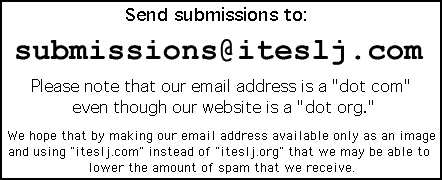The Internet TESL
Journal
Internet TESL Journal's
Submission Policy
How to Submit
Temporarily, we are not accepting new submissions.
This was our submission policy.
We are always looking for things that are of immediate practical use
to ESL/EFL teachers.
What We Accept
- Factors That Are Considered
- Is it of immediate practical use to ESL/EFL teachers?
- If the answer is "no," then the submission will be rejected.
- Our journal is aimed at teachers who are currently teaching. We are not interested in publishing papers that are only interesting to others doing research.
- Is the submission under our word limit of 2,500 words?
- We run a word count and do not read any paper that is above the word limit.
- We prefer well-written, concise articles to
verbose, wordy articles. Most articles we publish are well under the limit.
- This word limit includes charts, tables and references.
- Is the content of interest to a broad readership and not too specialized?
- Is it well written?
- Can it be formatted in a "web-like" manner with good sub-headings that
permit the reader to scan the page?
- The Types of Things We Publish
- Articles aimed at helping teachers teach better.
- Articles on teaching techniques.
- Even if it is a well-established, commonly-used technique that all experienced
teachers know, we are interested in publishing articles that new teachers
can benefit from reading.
- Lessons and lesson plans.
- Classroom handouts.
- Useful classroom aids: seating charts, speech evaluation forms, ...
The Type of Submissions We Reject
- Things that are not of immediate practical use to ESL/EFL teachers.
- Purely theoretical papers.
- Long, hard to read papers.
- Wordy and poorly-written papers.
- Descriptions of school English programs. However, using your own school
program as an example on how to use certain teaching techniques is acceptable.
- History of language learning or the history of English.
- Opinion surveys and most other surveys.
- Articles with many tables and charts are often rejected. These should only be included if absolutely necessary.
- Discussion of language use, grammar or linguistics. However, lessons on
how to teach specific grammar points or language use are considered.
- Things that are obviously written so that one can "pad" their resume.
- Things that are obviously written as class assignments. However,
we have published papers by graduate students if those papers were based
on experience.
- Web guides, sets of links and so on. These are soon out-dated.
How to Submit
Warning! Due to the large amount of junk mail and spam that we receive at this email address, please be sure that the first word in your subject line is "
SUBMISSION" (Step 3, below).
Otherwise, your submission might possibly be deleted automatically.
- Step One. Prepare the file.
- NOTE: You may send your article as a Word file. RTF, or text file only if your article includes no tables, charts or difficult layout.
- Layout your article using Netscape Composer (Freeware).
- Spell check your article. (This can be done even after you do the layout in Netscape Composer.)
- Count the words. If over 2,500 words, rewrite before submitting.
- At the top of the document please include this information.
Submission Date: (example: June 3, 1995)
Author: (Your full name)
Affiliation: (Where you work, if you want it to be included.)
Suggested Title: (This should be short enough to completely display as a bookmark
or in search engine results. The maximum is about 60 characters including the spaces.)
Word Count: (How many words in the document. Maximum is 2,500)
Suggested Category: (Article, Teaching Technique, Lesson/Lesson Plan, ...)
One-Line Description of Your Article:
(This is for the search engines. Keep it under 150
characters including spaces and punctuation.)
Contact Email Address: (Your email address)
Your Web Page URL: (If you have one.)
- Name the file as follows:
- The first word of the file name should be the author's (or one of the author's) last name (family name).
- Examples:
- Smith-UsingSongs.html
- (If you compress the HTML file, then "Smith-UsingSongs.zip" or "Smith-UsingSongs.sit.")
- (Smith-UsingSongs.doc or Smith-UsingSongs.txt -- See note above.)
- Step Two. Write a cover letter.
- Please make the subject of your submission email message as follows:
SUBMISSION - Author's Last Name - Title of Submission
Example SUBMISSION - Kelly - Writing Effective ESL/EFL Web Pages
- Copy "the author information" that is at the top of your submission and paste a copy into the email message.
Submission Date: (example: June 3, 1995)
Author: (Your full name)
Affiliation: (Where you work, if you want it to be included.)
Suggested Title: Suggested Title: (This should be short enough to completely display as a bookmark
or in search engine results. The maximum is about 60 characters including the spaces.)
Word Count: (How many words in the document. Maximum is 2,500)
Suggested Category: (Article, Teaching Technique, Lesson/Lesson Plan, ...)
One-Line Description of Your Article:
(This is for the search engines. Keep it under 150
characters including spaces and punctuation.)
Contact Email Address: (Your email address)
Your Web Page URL: (If you have one.)
- Include a brief abstract of the submission in the cover letter. (Copy and pasted from your article is fine.)
- Additionally, if not clear in your abstract, add a sentence or two about why you believe your article is something of immediate practical use to ESL/EFL teachers
- Step Three. Send the Message.
- Attach the file to the email meesage. The attachment should be HTML formatted as explained above If you like, you may compress the file using .zip, .sit, or.gz.
- E-mail the submission .
-

Reminder: The subject line should be like this.
SUBMISSION - Author's Last Name - Title of Submission
